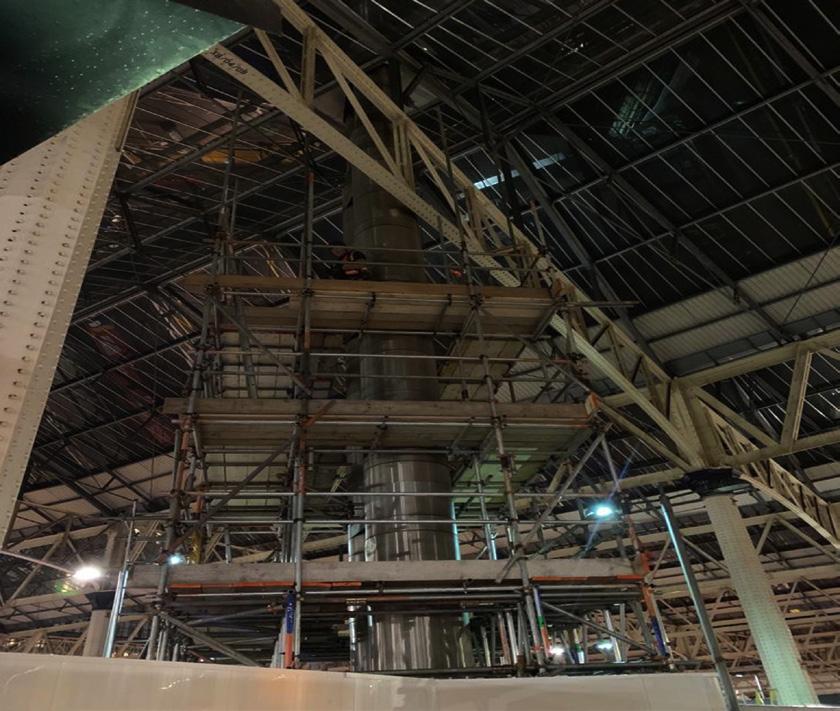Project Overview
The West Anglia Mainline (WAML) works involved the construction of a new line between Lea Bridge and the new Meridian Water station to feed a significant new housing development. This work upgraded the existing twin rail to a three line railway.
Our Role
Pod-Trak delivered the multidisciplinary scope of Earthworks, Civils, Permanent Way & OLE. All works were managed and self-delivered by Pod-Trak using our own staff and plant fleet.
Scope of Works
The Permanent Way scope comprised of:
- 6km of new ballast and track.
- New S&C Layouts at Lea Bridge and at Meridian Water
- Slab Trak at tight clearance overbridges
- Cable Management Sleepers
- Buffers, RRAPs & Lubricators
- Guard Rails
The OLE scope for the installation comprised of:
- Pile and Concrete Foundations
- Main Steel and SPS
- Wiring, Registration and Panning
- Neutral Sections, Section Insulators and Switching
- Traction Return Bonding
- HV Cables and MPTSC/FS upgrades
- Installation of Booster Transformers
- Section Proving and Commissioning
The Civil Engineering scope comprised of:
- Reduced Level dig and installation of 6 km’s of a Primary type 1 formation.
- Removal and reinstatement of soft spots providing CBR, DIN and materials testing at 50 meter intervals.
- Installation of perforated and carrier track drainage systems and deep surface water drainage systems.
- Construction of a 330m reinforced earthwork noise attenuation bund
- Civils & Structures (Bridges 666, 1391 & 1393)
- 1 Drainage and 5 Utility UTX’s.
- Culvert strengthening & scour protection works
- 750 meters of Elevated and Concrete trough works
- Site Wide Landscaping.
- Bridge foundation pile cropping to 1100mm CFA piles
- Bridge sub structure excavation & reinforced concrete works
- Crane & piling mat construction and removal
- New deck installation complete with bearings.
- FRC works to bridge decks.
- Bridge deck drainage.
Delivering Expertise
The scope included the installation of a new third line required to service the new station at Meridian water, the new line was 5445m in length and was planned to be installed during weekend possessions utilising a Kirow crane to lift in panels end on end. This methodology facilitated an output of 90 panels (circa 1 track mile) per weekend and was successfully implemented for approximately ½ the route up to Tottenham Hale Station.
Immediately south of Tottenham Hale station overbridge 1395 is situated, this bridge had exceptionally tight structure gauge clearances and a previously uncharted watermain identified during the construction phase. To allow the rail (and its imparted loads) to cross the watermain a new subterranean bridge had to be designed, approved (both Network Rail & Thames Water), and constructed before the track could be laid through the bridge. In effect the new constraint of the watermain and bridge 1395 prevented rail access to the northern ½ of the route, as such our planned construction methodology could not be adopted between Tottenham Hale & Meridian Water.
Pod-Trak were tasked with developing a methodology to lay bottom ballast, sleepers, rail & rail components, top ballast and tamp the rail locked corridor where two access points were available, one at Tottenham Hale and one at Northumberland Park. Due to the significant tonnage of material that had to be imported onto site it was quickly identified that a third access was required, as such a new RRAP was installed at Meridian Water such that it was possible to end feed from the site extremities and also feed from the central access at Northumberland Park. With access defined the following methodologies were deployed to deliver and install the track materials –
Bottom Ballast
Road hauled ballast stock piles created at the three RRAP locations. Ballast loaded from stockpiles into 10T Hydrema dumpers dropping bottom stone from the access to the midpoints between accesses. Bottom stone was loaded out in this way to prevent dumper traffic damage to the track formation.
Bottom Ballast Grading
Grading works was completed in a conventional way utilising a 3D laser dozer and triple wackers.
Sleeper Installation
To eliminate damage to the bottom ballast line and level, sleepers and slave rails were installed end on from rail. Starting from the access points sleepers laid and fine lined, and 60’ rails distributed and installed using McCulloch’s. Sleepers and rails were progressively installed creating a rail access from the new RRAP access points.
Top Ballast
With access now available over the new track top ballast was loaded from the ballast stockpiles into rail mounted dumpers which with their front and side tipping modes, distributed the top stone into the 4’ and cess. With the top stone dropped it was then graded in a conventional manner with RRV and profile bucket.
Tamping
With the rail access still not available through the mainline at bridge 1395 it was not possible to access a mainline tamper. With this a beaver tamper (lorry loaded) was accessed at Meridian Water which facilitated high quality track consolidation and alignment.
The above access and methodology allowed parallel construction on four work fronts, with each work front progressing towards each other to the centre points of the site. This allowed for all rail systems work to be completed at the same time as the availability of bridge 1395 where a new slab track section was constructed to join the two halves of the railway. With the railway now continuous to the mainline continuously welded rails were dropped by train and the slave rails replaced to allow the commissioning and entry into service on time and on programme.
Before commencement of foundation works, Pod-Trak conducted trial holes at every location and UXO probed where required. A percentage of the piling works were installed off track utilising a tracked machine and some on track using an RRV. At certain locations, we liaised with the designer to assist with solutions for bespoke concrete foundations where piles could not achieve the required depth, which were installed by Pod-Trak once temporary works and updated WPP had been established and implemented.
Due to numerous issues with the pile locations, the Main Steel was not ordered until RECOS’s had been confirmed, which assisted the project commercially and avoided programme constraints. Some of the new Main Steel had to interconnect with the existing structure within the Station areas, which had to be staged to reduce the disruption to the train timetables.
Installation of the SPS and supports were completed as the Main Steel was erected, with Cantilevers secured to avoid damage and risk of injury. The Cantilever supports would only be released once the conductors were being installed and secured across to existing OLE to avoid erratic movement. The Catenary and Contact for all wire runs were installed in possessions, as the risk was too high with live adjacent lines to run with ALO. Once installed, construction earths were applied, with a register being maintained until completion.
The aerial earth wire and return conductor installation were undertaken midweek under ALO due to the conductors being run with minimal tension, located on the CESS side of the new structures. Pod-trak deployed additional wire watchers with back-to-back radios to ensure the conductors did not snag. Upon completion of installation of the conductors, the team completed registration during midweek days under ALO, with the exception of a few locations being in close proximity to the existing live OLE. These locations were placed on our register for possession works only and labelled on site to ensure a clear demarcation was in place.
The Stage 1 works to re-configure Coppermill MPTSC was complex due to the different lines it fed and the distance to carry the new HV feeds. New portal structures were installed to carry the existing OLE. Once installed the existing structures were removed along with all the cross track and along track feeds from Coppermill TSC. Pod-Trak held meetings with Romford ECRO and Network Rail Distribution to arrange the feed diversions to allow Coppermill TSC to be isolated for a number of weeks. In total Pod-Trak installed 9 new 25Kv HV cables (Circa 1000M) in elevated troughing and through 2 UTX’s. The traction return bonding throughout the project was staged with temporary bonds applied to numerous items for other disciplines and our own temporary bonds to the Lea Valley
Reverse (LVR) line to maintain continuity. A bonding register was compiled and maintained throughout and was integrated with the final bonding plan to ensure all details was captured including Civils, Signalling, M&E and OLE. The main bonding was prepared in advance of the final signalling stage and all connected over a single commissioning weekend.
Once the tie in at Lea Bridge was installed, Pod-Trak delivered the section proving of the LVR, which included numerous switch operations over the 6.5km new line. The section proving document went through various checks before being authorized, with numerous visits to Romford ROC to discuss with the ECRO.
Several walkouts were attended prior to energisation with the Network Rail team and the Maintainer to ensure any outstanding works and/or snags were captured to avoid
repeated site attendance.
For the handback, we split Stage 3 into A & B to enable a faster return of handback documents, which included;
- Quality check sheets for each task on every structure
- Red line drawings (cross sections, allocation sheets and layouts)
- All the material compliance records.
Once submitted and accepted, the agreed ITP was finalised. The new equipment installed was Series 2, which was a first in the area for the maintainer. We procured the appropriate spares for the team and held a training day with their staff to explain the main differences.
Health, Safety & Welfare
We were actively involved with ‘What Good Looks Like’, which was delivered every Friday on the project for all to attend, to listen to how each discipline was performing. The main purpose of this, was to highlight any errors from Close Calls and how this was rectified to make good.

